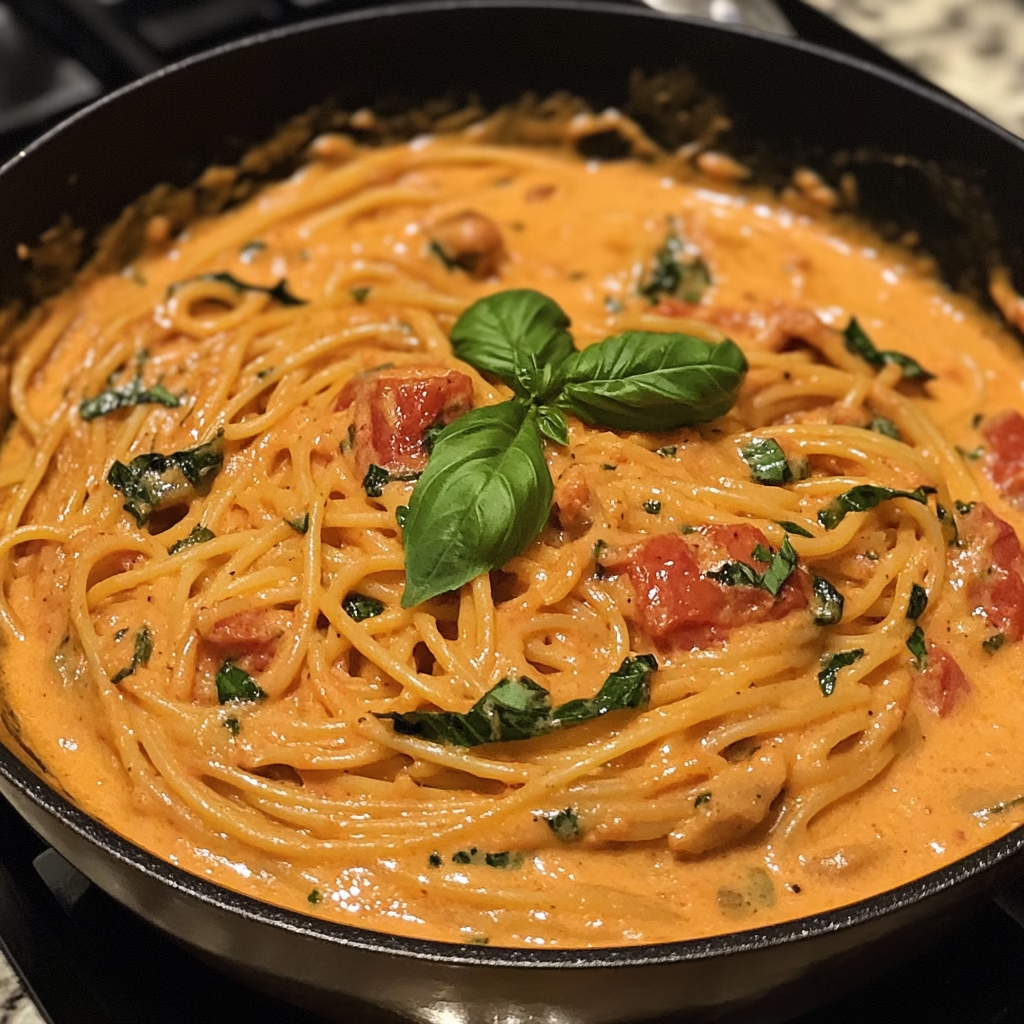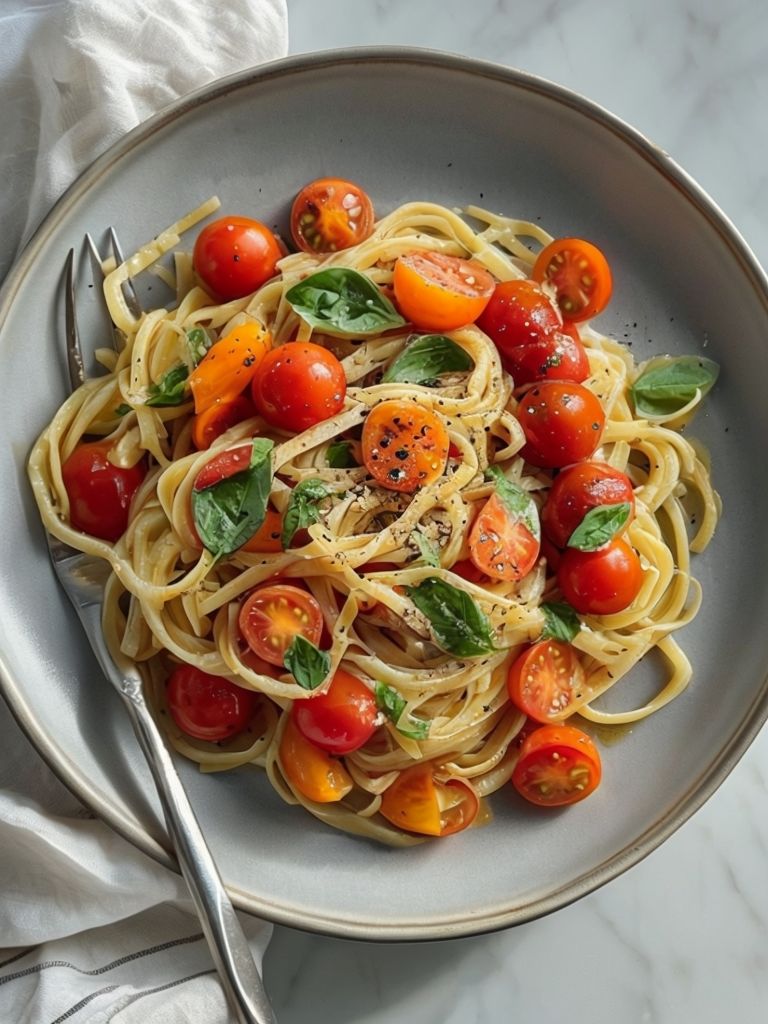Creamy Tomato Basil Pasta: The Ultimate Guide
Introduction to Creamy Tomato Basil Pasta
When it comes to comfort food, few dishes can rival the allure of Creamy Tomato Basil Pasta. This classic meal blends the rich tanginess of tomatoes, the fragrant freshness of basil, and the luscious creaminess of a perfectly cooked sauce. Loved worldwide for its simplicity and flavor, this dish transcends cultural boundaries, appealing to home cooks and professional chefs alike.
Whether you’re looking to recreate a restaurant-style meal at home or introduce a versatile dish to your repertoire, Creamy Tomato Basil Pasta is the perfect candidate. In this article, we’ll uncover its rich history, break down the essential ingredients, and explore everything you need to know to make it a star dish in your kitchen.
Why Creamy Tomato Basil Pasta is a Popular Dish
What makes Creamy Tomato Basil Pasta such a crowd-pleaser?
- Versatility: It’s adaptable, allowing you to use different types of pasta or proteins.
- Flavor Harmony: The combination of cream, tomato, and basil strikes a balance between tangy and savory.
- Ease of Preparation: Perfect for weeknight dinners or special occasions, it’s straightforward and quick to prepare.
- Universal Appeal: This dish can be adjusted to suit vegetarian, vegan, and gluten-free diets, making it inclusive for all eaters.
No matter the occasion, the creamy tomato and basil combination promises satisfaction in every bite.
The History of Tomato-Based Pasta Dishes
Tomato-based pasta sauces have their roots in Italian cuisine, with the tomato first introduced to Europe in the 16th century. By the 18th century, tomatoes became a staple ingredient in Italian households, transforming how pasta was served.
The creamy variation likely emerged from a fusion of traditional Italian techniques and modern culinary trends. Adding cream to the tangy tomato sauce creates a richer, smoother texture, which complements the earthy sweetness of fresh basil. Today, Creamy Tomato Basil Pasta has become a global favorite, especially in Italian-American cuisine.
What Makes Creamy Tomato Basil Pasta Unique?
While many pasta dishes incorporate tomato and cream, Creamy Tomato Basil Pasta stands out for its:
- Freshness: The inclusion of fresh basil elevates the dish, adding a fragrant, herbal note that balances the rich sauce.
- Customizability: From penne to fettuccine, any pasta shape works beautifully with this sauce.
- Comfort Factor: The creamy texture makes it hearty and indulgent, while the tomato and basil keep it refreshing.
This duality of comfort and elegance is what sets it apart from other pasta dishes.
Key Ingredients Needed for Creamy Tomato Basil Pasta
To create a perfect dish, each ingredient plays a pivotal role. Let’s break them down:
Selecting the Best Tomatoes for Sauce
The quality of tomatoes significantly impacts the sauce’s flavor. Options include:
- Fresh Roma Tomatoes: Their low water content and natural sweetness make them ideal for sauces.
- Canned San Marzano Tomatoes: These Italian tomatoes are prized for their deep flavor and balanced acidity.
- Cherry Tomatoes: For a slightly sweeter and tangier twist.
Fresh Basil: The Star Herb of the Dish
Basil is the cornerstone of this dish, contributing its signature aroma and flavor. Always use:
- Fresh Basil Leaves: Their vibrancy and fragrance are unmatched by dried alternatives.
- Add basil toward the end of cooking to retain its freshness and prevent bitterness.
Types of Pasta That Pair Best with Creamy Tomato Basil Sauce
While any pasta can work, these varieties excel:
- Penne: Its ridges hold the creamy sauce beautifully.
- Fettuccine: Perfect for a luxurious dining experience.
- Spaghetti: A classic choice for light yet satisfying results.
Nutritional Overview of Creamy Tomato Basil Pasta
Balancing indulgence with health is achievable with Creamy Tomato Basil Pasta. Here’s why it’s a well-rounded option:
- Tomatoes: Packed with vitamins A, C, and antioxidants like lycopene.
- Basil: Adds a nutrient boost with its anti-inflammatory properties and essential oils.
- Cream: Provides richness, but you can opt for lighter versions or alternatives.
- Pasta: Choose whole-grain or gluten-free varieties for added fiber and reduced carbs.
Balancing Creaminess and Freshness for a Healthy Meal
To maintain a balance:
- Use half-and-half cream instead of heavy cream for a lighter option.
- Incorporate more tomatoes or roasted vegetables to enhance freshness.
- Sprinkle Parmesan sparingly to control sodium levels while maximizing flavor.
Step-by-Step Recipe and Cooking Techniques
How to Make Creamy Tomato Basil Pasta: A Step-by-Step Guide
Creating Creamy Tomato Basil Pasta is a straightforward process that ensures a restaurant-quality meal right in your kitchen. This guide breaks down every step, from preparing the sauce to perfecting the pasta.
Preparing the Tomato Basil Sauce
The heart of this dish lies in its creamy tomato basil sauce. Follow these steps for a rich, flavorful result:
Blanching and Peeling Fresh Tomatoes
Fresh tomatoes create a vibrant and natural sauce. Here’s how to prepare them:
- Blanch the Tomatoes:
- Boil water in a large pot.
- Cut a small « X » on the bottom of each tomato and immerse them in boiling water for 30 seconds.
- Transfer the tomatoes immediately into an ice water bath to cool.
- Peel the Skins:
- Once cooled, gently peel off the skins. They should slide off easily.
- Dice the Tomatoes:
- Remove the seeds (optional) and chop the tomatoes finely.
If using canned tomatoes, simply crush them by hand or with a fork for a rustic texture.
Infusing Garlic, Onion, and Herbs into the Sauce
To build depth of flavor:
- Sauté Aromatics:
- Heat olive oil in a skillet over medium heat.
- Add finely chopped onions and minced garlic. Cook until soft and fragrant.
- Add Tomatoes:
- Stir in the prepared tomatoes and let the mixture simmer for 10–15 minutes.
- Season Generously:
- Add salt, black pepper, and a pinch of red chili flakes for mild heat.
- Incorporate fresh or dried Italian herbs like oregano and thyme.
Adding Cream for a Luxurious Texture
The final touch is the cream:
- Stir in heavy cream, half-and-half, or a dairy alternative for a velvety consistency.
- Simmer for another 5–7 minutes until the sauce thickens.
- Add freshly chopped basil leaves just before removing the sauce from the heat.
« For a deeper dive into the benefits of basil and its culinary uses, check out this comprehensive guide from Healthline. »
Cooking the Pasta
Properly cooked pasta is crucial for this dish’s success.
Choosing the Perfect Cooking Time Based on Pasta Type
Different pasta shapes have varying cooking times:
- Penne: 10–12 minutes
- Fettuccine: 8–10 minutes
- Spaghetti: 7–9 minutes
Always check the package instructions and cook until al dente—firm to the bite.
Salting the Water for Flavor
Never skip this step:
- Use 1–2 tablespoons of salt per gallon of water. This enhances the pasta’s flavor as it cooks.
- Boil the water vigorously before adding the pasta.
Combining the Sauce and Pasta
The final step is combining the pasta with the creamy tomato basil sauce.
Tips for Perfectly Coating Pasta with Sauce
- Reserve Pasta Water:
- Save 1 cup of pasta water before draining. This starchy water helps the sauce adhere to the pasta.
- Mix on Low Heat:
- Add the drained pasta directly to the skillet with the sauce.
- Toss gently over low heat to coat evenly.
- Adjust Consistency:
- If the sauce feels too thick, add a splash of reserved pasta water.
Garnishing the Dish with Fresh Basil and Parmesan
The finishing touches bring this dish to life:
- Sprinkle freshly grated Parmesan cheese on top.
- Add whole basil leaves or a chiffonade (thin strips) of basil for a pop of color and flavor.
- Drizzle with extra virgin olive oil for added richness.

Variations, Pairings, and Expert Tips
Creative Variations of Creamy Tomato Basil Pasta
One of the best things about Creamy Tomato Basil Pasta is its versatility. By tweaking the ingredients or adding extras, you can create exciting variations that cater to different preferences.
Adding Protein: Chicken, Shrimp, or Tofu
Elevate your pasta with protein-rich options:
- Chicken: Sear bite-sized chicken pieces in olive oil with a pinch of salt and pepper. Mix into the sauce before combining with pasta.
- Shrimp: Lightly sauté shrimp with garlic and chili flakes. Their delicate flavor pairs beautifully with the creamy sauce.
- Tofu: For a vegetarian twist, use pan-fried tofu cubes seasoned with Italian herbs.
Each protein enhances the dish’s flavor while making it more filling.
Vegan and Dairy-Free Versions
A plant-based version of Creamy Tomato Basil Pasta is easy to achieve without compromising flavor.
Replacing Cream with Plant-Based Alternatives
- Coconut Cream: Adds a subtle sweetness while maintaining the creaminess.
- Cashew Cream: Blend soaked cashews with water for a smooth, dairy-free substitute.
- Oat Milk Creamer: A neutral option for a creamy texture without strong flavors.
Additional Tips
- Replace Parmesan with nutritional yeast for a cheesy flavor.
- Ensure the pasta is egg-free to keep the dish vegan.
Gluten-Free and Low-Carb Pasta Options
For those avoiding gluten or carbs, consider these alternatives:
- Gluten-Free Pasta: Made from rice, corn, or quinoa, these mimic traditional pasta textures.
- Zucchini Noodles: Spiralized zucchini provides a low-carb, refreshing alternative.
- Chickpea or Lentil Pasta: Packed with protein and fiber, these options offer a satisfying bite.
Side Dishes and Pairings for Creamy Tomato Basil Pasta
Pairing Creamy Tomato Basil Pasta with complementary sides creates a complete and memorable meal.
Fresh Salads: Caesar or Caprese
- Caesar Salad: Crisp romaine lettuce, croutons, and a creamy dressing make an excellent accompaniment.
- Caprese Salad: Fresh mozzarella, ripe tomatoes, basil, and balsamic drizzle mirror the pasta’s flavors for a cohesive pairing.
Breads and Appetizers to Serve Alongside
- Garlic Bread: A classic choice for soaking up the creamy sauce.
- Bruschetta: Toasted baguette slices topped with diced tomatoes, basil, and olive oil add a light, crunchy contrast.
- Stuffed Mushrooms: Filled with cheese, herbs, or breadcrumbs, they bring an elegant touch to the table.
Expert Tips for Perfect Creamy Tomato Basil Pasta
Mastering the art of this dish requires attention to detail. Here are some insider tips:
Avoiding a Runny Sauce
- Simmer Longer: Let the sauce cook down on low heat to concentrate its flavors.
- Use High-Quality Cream: Low-fat options can result in a thinner consistency.
- Incorporate Tomato Paste: Adding a tablespoon boosts the thickness and flavor of the sauce.
Storing and Reheating Leftovers
Proper storage and reheating ensure your pasta tastes just as good the next day:
- Cool Completely: Let the pasta cool before transferring it to an airtight container.
- Refrigerate or Freeze:
- Store in the refrigerator for up to 3 days.
- Freeze in portioned containers for up to 2 months.
- Reheat Gently:
- Use a skillet over low heat, adding a splash of milk or cream to restore the sauce’s creaminess.
- Avoid microwaving, which can make the sauce separate.
FAQs
Here are 10 frequently asked questions about Creamy Tomato Basil Pasta:
- Can I make this dish ahead of time? Yes, prepare the sauce in advance and refrigerate. Cook the pasta fresh and combine when ready to serve.
- What’s the best way to reheat creamy pasta? Reheat on low heat with added cream or milk to maintain the sauce’s texture.
- How do I prevent basil from turning black? Add fresh basil at the end of cooking and avoid overcooking it in the sauce.
- Can I use dried basil instead of fresh? Yes, but the flavor will be less vibrant. Use half the amount of dried basil as fresh.
- What type of cream works best? Heavy cream is ideal, but half-and-half or plant-based alternatives work too.
- Is this dish freezer-friendly? The sauce freezes well, but combine it with freshly cooked pasta for the best texture.
- What wines pair well with this dish? Pair with a light red wine like Pinot Noir or a crisp white like Sauvignon Blanc.
- Can I skip the cream for a lighter version? Yes, use a tomato-only sauce or blend roasted vegetables for creaminess.
- How can I add more vegetables to the dish? Include roasted bell peppers, zucchini, or spinach in the sauce.
- What’s the best cheese for garnishing? Parmesan is traditional, but Pecorino Romano or Grana Padano are great alternatives.

